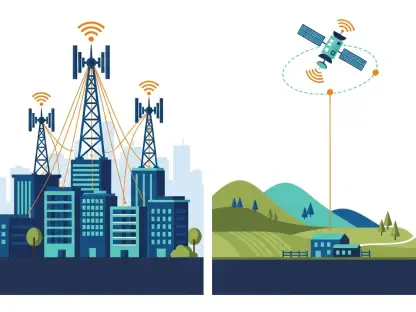Comcast and Charter Navigate Fiber Competition and Wireless Futures
As Comcast and Charter prepare to release their third-quarter earnings reports, the shifting sands of the telecommunications and cable sectors have become unmistakably evident. These giants are grappling with declining growth in equity values amidst fierce competition from fiber-optic and fixed wireless providers. The traditional “Triple Play” model of bundling High-Speed Internet, Linear Cable, and Home Phone services is now under siege from streaming platforms like YouTube TV, Hulu, and Netflix. This article delves into their strategic maneuvers to maintain market relevance.
Transition from Traditional Services
Decline of the “Triple Play” Model
Once a staple offering, the “Triple Play” model is no longer the powerhouse it used to be. The rise of streaming services has significantly reduced the appeal of linear cable television, compelling Comcast and Charter to rethink their positioning. The shift towards offering high-speed internet and wireless services reflects a broader industry trend of moving away from video-centric bundles. This evolution is driven by the changing consumer preferences favoring flexible, on-demand content over traditional programming schedules. Consumers are increasingly cutting the cord in favor of platforms that allow them to curate their own viewing experiences, thus reducing subscriptions to traditional cable TV services.
As a result, Comcast and Charter are prioritizing their broadband offerings and transforming their service models to adapt to this new reality. The challenge lies in successfully transitioning their massive customer bases, accustomed to bundled services, to more contemporary and flexible packages. While broadband remains a robust segment, despite the pressure from fiber-optic networks, generating sustainable growth requires innovative strategies to enhance user experience and integrate value-added services. This gradual pivot recognizes the necessity for these cable giants to evolve and remain competitive against disruptive technological advancements and changing consumer habits.
Embracing Wireless Services
Both Comcast and Charter are increasingly placing their bets on wireless services to drive growth. The expansion into mobile services is seen as a natural extension, leveraging the extensive networks they already have in place. Charter, in particular, has made significant strides with its aggressive pricing strategies, setting a benchmark for Comcast to follow. Charter’s success in the mobile sector not only contributes to its revenue streams but also fortifies customer loyalty by offering comprehensive service bundles that integrate mobile and broadband.
This shift highlights the necessity for cable operators to diversify and tap into the burgeoning wireless market, especially as fixed wireless gains traction. With competitors like T-Mobile and AT&T pushing forward with innovative wireless solutions, remaining static is not an option. The move into wireless does have its complexities, requiring substantial investment in marketing, network infrastructure, and customer acquisition strategies to effectively compete in this crowded space. However, the potential payoff is substantial, as consumers increasingly demand seamless connectivity that spans their home and mobile environments. For Comcast and Charter, wireless services represent not just an additional revenue stream but a critical step towards staying relevant in a rapidly evolving market.
5G and Fixed Wireless Services
Impact and Opportunities of 5G
The advent of 5G has been hailed as a game-changer for telecommunications, but its impact on the mass market remains limited. For Comcast and Charter, 5G represents more of an opportunity to enhance network scalability and profitability than to introduce groundbreaking consumer applications. By investing in 5G, these companies aim to improve service delivery and network efficiency, thereby retaining customers who might otherwise be lured away by the promises of fiber-optic offerings. Moreover, the deployment of 5G is pivotal for supporting the increasing demand for high-speed internet, driven by the proliferation of smart devices and data-intensive applications.
Implementing 5G technology enables Comcast and Charter to better manage network congestion, reduce latency, and offer higher bandwidth, which are critical factors in staying competitive against fiber providers. While 5G’s full potential as a revolutionary consumer application platform has yet to be realized, its role in strengthening the existing network infrastructure is undeniable. This strategic focus on network enhancement underscores the broader industry trend towards achieving operational efficiencies and delivering superior customer experiences. As these companies continue to roll out 5G infrastructure, the long-term benefits could include increased customer retention and expanded service capabilities, fortifying their positions in the market.
Fixed Wireless as a Competitive Edge
Fixed wireless services have emerged as a formidable competitor to traditional cable offerings, particularly in underserved areas where laying fiber-optic cables is not cost-effective. For Comcast and Charter, delving into fixed wireless presents an opportunity to reach new customer segments and provide high-speed internet alternatives, thus broadening their customer base. Fixed wireless, which delivers internet services via radio signals from a nearby cell tower, offers a viable solution in rural and remote locations where traditional broadband infrastructure is lacking.
Additionally, this move is pivotal in transitioning from their dependence on physical cable networks, marking a significant strategic pivot. Fixed wireless can be deployed faster and at a lower cost compared to fiber, providing a competitive edge in terms of scalability and market penetration. By expanding their fixed wireless offerings, Comcast and Charter can mitigate the risk of losing customers to fiber-optic competitors and capture a share of the market that was previously inaccessible. This strategy not only diversifies their service portfolio but also aligns with the broader industry shift towards more flexible and cost-effective broadband solutions, positioning them better for future growth.
Competition with Fiber-Optic Providers
Fiber’s Technological Superiority
The technological advantages of fiber-optic networks pose a considerable challenge to Comcast and Charter. With higher speeds, lower latency, and fewer oversubscription issues, fiber is increasingly outpacing cable in customer satisfaction. Fiber-optic technology offers a more consistent and reliable internet experience, making it a preferred choice for consumers seeking high-performance connectivity. This competitive pressure underscores the need for cable operators to enhance their broadband offerings continuously, ensuring they can meet and exceed the performance standards set by fiber-optic solutions.
For Comcast and Charter, maintaining competitiveness means investing in infrastructure upgrades and leveraging advanced technologies to improve service quality. This includes exploring hybrid models that integrate fiber and coaxial cables to deliver enhanced broadband capabilities. By adopting such strategies, they can offer higher-speed internet bundles and reduced latency, addressing some of the chief advantages fiber-optic providers hold. Furthermore, showcasing the practical benefits of their services, such as improved user experiences for gaming, streaming, and remote work, is essential in retaining and attracting customers in this fiercely competitive landscape.
Strategies for Competition
To stay competitive, Comcast and Charter are exploring multiple strategies, including potential acquisitions and partnerships. Charter’s rumored interest in acquiring parts of Altice exemplifies the kind of bold moves required to fortify market positioning. Such strategic investments aim to create synergies, reduce operational costs, and enhance service delivery, thereby positioning them better against fiber and other emerging broadband technologies. Mergers and acquisitions can provide access to new markets, advanced technologies, and additional customer bases, bolstering overall market presence.
Additionally, partnerships with tech companies and content providers can enhance service portfolios and deliver added value to subscribers. By collaborating with OTT platforms, smart home technology vendors, and other innovative entities, Comcast and Charter can offer comprehensive and integrated services that meet the diverse demands of today’s consumers. This multipronged approach to competition underscores an adaptive strategy focused on innovation, operational efficiency, and market expansion. It also highlights the critical importance of agility in responding to technological advancements and shifting consumer preferences, ensuring sustained growth and relevance in a dynamic industry.
Asset Utilization and New Opportunities
Leveraging Existing Assets
Maximizing the potential of existing assets is crucial for Comcast and Charter’s sustained growth. By optimizing their extensive networks and infrastructure, these companies can improve service delivery and operational efficiency. This includes enhancing broadband capabilities, expanding mobile service footprints, and making strategic use of spectrum allocations. Effective asset utilization helps mitigate the costs associated with large-scale infrastructure upgrades while maximizing returns on investment. Leveraging existing assets also involves deploying advanced technologies such as AI and machine learning to optimize network performance and forecast customer demand.
Additionally, Comcast and Charter are focusing on streamlining operations to reduce redundancies and improve service efficiencies. Initiatives like network virtualization and the deployment of edge computing can enhance service delivery by reducing latency and improving data processing capabilities. These efforts reflect a broader industry trend towards smarter, more efficient network management practices designed to enhance customer experiences and drive profitability. By continuously refining and optimizing their infrastructure, Comcast and Charter can remain competitive and agile, better positioned to respond to market demands and technological advancements.
New Service Innovations
Exploring and capitalizing on new service innovations is another avenue through which Comcast and Charter can reinvent themselves. The development and deployment of platforms like Xumo highlight attempts to tap into the streaming market. However, traction has been slower than anticipated, prompting a reevaluation of marketing strategies and service enhancements to better engage consumers and capture market share. Investing in content creation and exclusive partnerships can enhance the appeal of their streaming services, offering differentiated value propositions compared to established players like Netflix and Hulu.
Moreover, innovation in service delivery models, such as experimenting with bundled services that incorporate smart home technologies, cloud gaming, and cybersecurity solutions, presents additional revenue opportunities. By offering holistic and integrated digital experiences, Comcast and Charter can attract a broader demographic and increase customer loyalty. Emphasizing innovations that cater to emerging consumer trends, such as remote work and digital learning, also positions these cable operators as forward-thinking and responsive to changing market needs. This proactive approach to innovation underscores the importance of continuous evolution in maintaining competitive advantage and driving long-term growth.
Spectrum Strategy and Mobile Pricing
Importance of Spectrum Utilization
The strategic acquisition and utilization of spectrum play a critical role in enhancing service quality and competitive positioning. Both Comcast and Charter are expected to pursue additional spectrum purchases, particularly in shared spectrum spaces, to bolster their service offerings. Spectrum is a vital asset in delivering high-speed, reliable wireless services and supports the expansion of 5G and fixed wireless networks. Effective spectrum management allows these companies to enhance network capacity, reduce congestion, and deliver superior broadband experiences to their customers.
Moreover, strategic spectrum acquisitions can provide a competitive edge by enabling more efficient and robust wireless service deployment. This has become increasingly important as consumer demand for high-quality, uninterrupted connectivity continues to rise. By securing additional spectrum, Comcast and Charter can better position themselves to meet future demand and roll out next-generation services that require substantial bandwidth. This forward-looking spectrum strategy is integral to maintaining their competitive edge and ensuring the scalability of their wireless offerings as customer needs evolve.
Competitive Mobile Pricing
In the mobile sector, aggressive pricing and promotional strategies have proven effective for Charter, leaving Comcast trailing slightly behind. There is a growing recognition that Comcast needs to align more closely with Charter’s pricing strategies to remain competitive. This includes offering attractive deals and innovative packages that can draw customers away from other wireless providers and sign on for their services. Competitive pricing not only attracts new customers but also enhances customer retention by delivering perceived value and cost savings.
Furthermore, crafting flexible mobile plans that offer customization options and value-added services can differentiate Comcast’s offerings in a crowded market. Such plans might include data rollover, family-sharing options, and bundled discounts with broadband services, creating a more compelling value proposition. Ensuring that these plans are straightforward and transparent is also crucial in building consumer trust and satisfaction. By adopting a competitive pricing approach aligned with market demands, Comcast can improve its position in the mobile sector and drive subscriber growth.
Customer Retention and Acquisition
Importance of Superior Service
Retaining customers through superior service delivery remains paramount. As competition intensifies, ensuring robust customer experiences becomes essential. Both Comcast and Charter must focus on providing high-quality, reliable service to prevent churn and maintain their customer bases. Enhancing customer service across all touchpoints—from technical support to billing inquiries—is critical in fostering customer loyalty. Investments in customer service training, streamlined processes, and user-friendly digital interfaces can significantly impact customer satisfaction and retention rates.
Moreover, offering innovative and differentiated service bundles that cater to the diverse needs of consumers can enhance loyalty. By understanding and anticipating customer needs, Comcast and Charter can develop tailored solutions that exceed expectations, creating lasting value. Additionally, proactive engagement through loyalty programs, personalized offers, and seamless omnichannel experiences can further strengthen customer relationships. Superior service delivery is not just about meeting customer expectations but consistently exceeding them, ensuring a competitive edge in retaining and acquiring customers.
Strategic Acquisitions and Innovative Marketing
As Comcast and Charter get ready to announce their third-quarter earnings, it’s clear that the telecommunications and cable industries are going through significant changes. Both companies are currently facing challenges with decreasing equity values as they compete against fiber-optic and fixed wireless providers. The once-dominant “Triple Play” model, which bundles High-Speed Internet, Linear Cable, and Home Phone services, is now under serious threat from streaming giants like YouTube TV, Hulu, and Netflix. This article explores the strategic steps Comcast and Charter are taking to stay relevant in a rapidly evolving market.
Comcast and Charter are forced to innovate to keep up with the competition. They are increasingly investing in improving their broadband services to deliver faster and more reliable internet to their customers. Additionally, both companies are focusing on enhancing their streaming services, either by creating their platforms or by partnering with existing ones. For instance, Comcast’s Peacock is an attempt to capture the streaming market share, while Charter continues to explore partnerships to expand its digital offerings.
Moreover, the shift towards mobile services plays a pivotal role in their strategies. By offering competitive mobile plans, Comcast and Charter aim to attract and retain customers who are looking for comprehensive telecom solutions. These efforts highlight their commitment to adapting to market trends and customer preferences, ensuring they maintain a strong presence despite the competitive pressures from emerging technologies and platforms.









